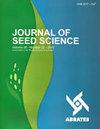Chemical seed treatments for the control of cotton seedling damping-off caused by Rhizoctonia solani under greenhouse conditions
IF 1.2
4区 农林科学
Q3 AGRONOMY
引用次数: 0
Abstract
Abstract: The aim of this study was to determine the effectiveness of cotton seed treatment with fungicides in the control of seedling damping-off caused by Rhizoctonia solani, under greenhouse conditions. Treated and untreated delinted seeds of the cultivar DeltaOpal were sowed in sand contained in plastic trays, placed in individual and equidistant wells, 3 cm deep. Into each plastic tray were put 3.0 g of the pathogen inoculum. The inoculation of R. solani AG-4 was done by the homogeneous distribution of the fungus inoculum onto the substrate. The fungus was grown for 35 days on autoclaved oat seeds and then ground to powder using a mill (1 mm). Fungicide seed treatments had a significant effect (P ≤ 0.05) on initial and final seedling emergence, pre and post-emergence damping-off, injured seedlings and disease index according to McKinney formula (lesion severity). The best results were obtained by fludioxonil + metalaxyl-M + azoxystrobin, fipronil + pyraclostrobin + methyl-thiophanate, carbendazim + thiram + pencycuron + baytan and carbendazim + thiram + pencycuron + baytan + procymidone. Pearson correlation analysis indicated that injured seedlings and disease index were positively correlated (R = 0.95). This means that the greater the number of injured seedlings, the greater the disease index and the less efficient the fungicide. The fungicides used in the present study did not have any phytotoxic effect on cotton seedlings.化学种子处理防治温室条件下番茄丝核菌引起的棉花萎蔫
摘要/ Abstract摘要:本试验旨在探讨在温室条件下,棉花种子施用杀菌剂对茄枯丝核菌灭苗的防治效果。将DeltaOpal品种经过处理和未处理的脱色种子播种在塑料托盘中的沙子中,放置在3厘米深的单孔和等距井中。每个塑料托盘中放入3.0 g病原体接种物。通过将真菌接种物均匀分布在基质上,实现了茄枯病菌AG-4的接种。真菌在高压灭菌的燕麦种子上生长35天,然后用磨(1毫米)磨成粉末。按麦金尼公式(病变严重程度)计算,杀菌剂种子处理对幼苗出苗期和出苗期、出苗期和出苗期阻尼、伤苗和病害指数均有显著影响(P≤0.05)。以氟虫腈+甲氧基- m +嘧菌酯、氟虫腈+吡唑菌酯+甲基硫代酸盐、多菌灵+西蓝姆+苯曲龙+ baytan、多菌灵+西蓝姆+苯曲龙+ baytan +原嘧酮的效果最好。Pearson相关分析表明,伤苗与病害指数呈正相关(R = 0.95)。这意味着受伤的幼苗数量越多,病害指数越大,杀菌剂的效率越低。本研究使用的杀菌剂对棉花幼苗没有任何植物毒性作用。
本文章由计算机程序翻译,如有差异,请以英文原文为准。
求助全文
约1分钟内获得全文
求助全文
来源期刊

Journal of Seed Science
Agricultural and Biological Sciences-Agronomy and Crop Science
CiteScore
2.00
自引率
30.00%
发文量
28
审稿时长
12 weeks
期刊介绍:
From 2017 the Journal of Seed Science (JSS) will circulate online version only.
Original scientific studies and communications, not yet published or submitted to another journal for publication and written in Portuguese or English, will be accepted for publication. For manuscripts submitted in English, the authors should provide an adequated version.
The SCIENTIFIC COMMUNICATION is a category of scientific manuscript which describes a technique, an equipment, new species or observations and surveys of limited results. It has the same scientific rigor as the “Scientific Articles” and the same value as a publication. The classification of a manuscript as a SCIENTIFIC COMMUNICATION is based on its content and scientific merit but it can be a preliminary study, simple and not definitive on a certain subject, with publication justified by its uniqueness and contribution to the area.
The Editorial Board of the JSS may invite leading authors of recognized reputation to compose specific Review Articles covering topics of their specialization that will convey to the scientific community the state-of-the-art knowledge related to the specific theme.
 求助内容:
求助内容: 应助结果提醒方式:
应助结果提醒方式:


